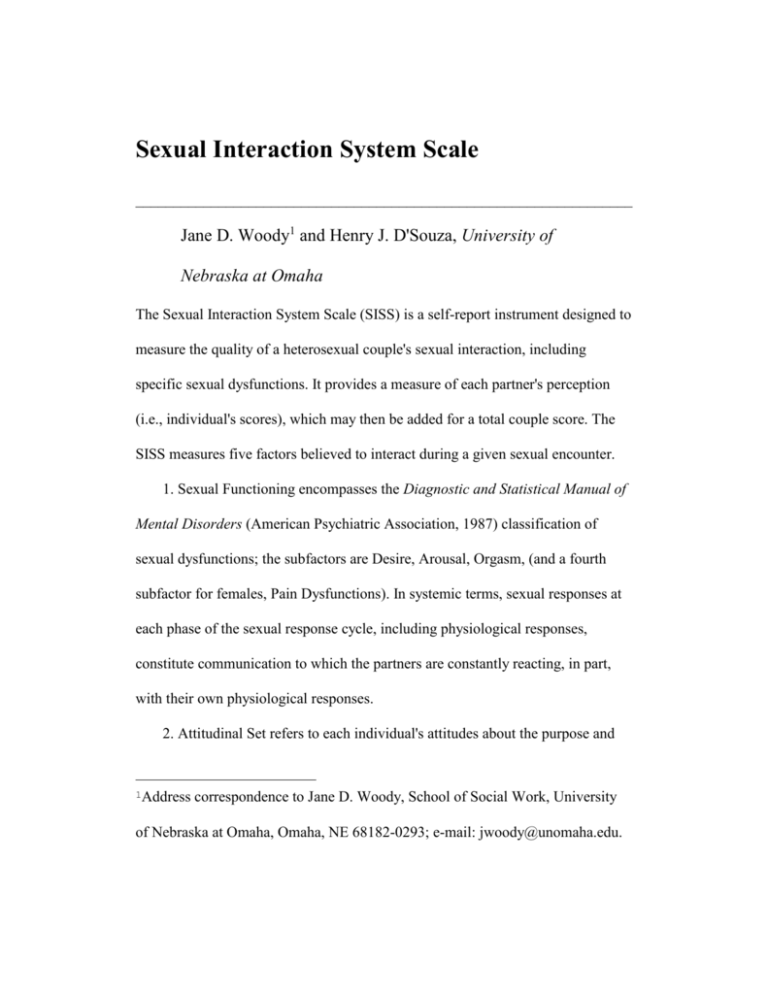
Sexual Interaction System Scale
__________________________________________________________________
Jane D. Woody1 and Henry J. D'Souza, University of
Nebraska at Omaha
The Sexual Interaction System Scale (SISS) is a self-report instrument designed to
measure the quality of a heterosexual couple's sexual interaction, including
specific sexual dysfunctions. It provides a measure of each partner's perception
(i.e., individual's scores), which may then be added for a total couple score. The
SISS measures five factors believed to interact during a given sexual encounter.
1. Sexual Functioning encompasses the Diagnostic and Statistical Manual of
Mental Disorders (American Psychiatric Association, 1987) classification of
sexual dysfunctions; the subfactors are Desire, Arousal, Orgasm, (and a fourth
subfactor for females, Pain Dysfunctions). In systemic terms, sexual responses at
each phase of the sexual response cycle, including physiological responses,
constitute communication to which the partners are constantly reacting, in part,
with their own physiological responses.
2. Attitudinal Set refers to each individual's attitudes about the purpose and
1Address
correspondence to Jane D. Woody, School of Social Work, University
of Nebraska at Omaha, Omaha, NE 68182-0293; e-mail: jwoody@unomaha.edu.
focus of sexual intimacy and the level of maturity that these attitudes reflect—
whether self-focused, role focused, or individual connected.
3. Nonsexual Interaction refers to the presence of interactions around
territoriality, ranking, attachment, and exploratory/sensory patterns that may either
promote or interfere with desired sexual arousal and satisfaction. This factor taps
patterns that a couple has established for dealing with these issues in their overall
relationship and which may emerge and be communicated during the sexual
encounter.
4. Interaction Coordination refers to the partners' action language that serves
to coordinate all aspects of the sexual encounter so as to lead to the desired
outcome—arousal and satisfaction. It encompasses verbal and nonverbal
behaviors that serve as communication exchanges that may move the couple's
sexual interaction in the desired direction.
5. Postsexual Interaction refers to the emotional tenor of the relationship
following sex. It consists of each partner's evaluation of the sexual encounter
relative to feelings and behaviors of distance versus closeness toward the partner
as a result of the sex. These feelings, and behaviors too, constitute communication
that is assumed to carry over and impact on the couple's next sexual encounter.
Description
The SISS is distinct from prior sexual functioning inventories in that it focuses on
the interaction taking place during the couple's actual sexual encounters. In spite
of the fact that the couple is typically the preferred unit of treatment for sexual
dysfunctions, a systemic understanding of a couple's sexual relationship is a fairly
recent development (Schnarch, 1991; Woody, 1992). The five factors were
derived in part from Verhulst and Heiman's (1979) systemic explanation of sexual
functioning as an interactional communication process. The SISS consists of 48
statements with responses to be made on a 6-point scale (0 = none, never, does not
occur in our relationship to 5 = high, always, always occurs in our relationship).
Of these statements, 10 items deal with Sexual Functioning, 7 with Attitudinal
Set, 12 with Nonsexual Interaction, 6 with Interaction Coordination, and 10 with
Postsexual Interaction. The SISS is appropriate for use with heterosexual couples
in clinical practice involving sexual distress, sexual dysfunction, or general
relationship problems, and for use in couple premarital and enrichment programs.
Additional material pertaining to this scale, including information about
format, scoring, reliability, and validity is available in Fisher, Davis, Yarber, and
Davis (2010).
Fisher, T. D., Davis, C. M., Yarber, W. L., & Davis, S. L. (2010). Handbook of
Sexuality-Related Measures. New York: Routledge.







